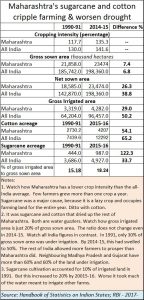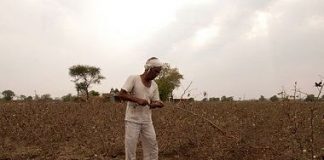https://www.moneycontrol.com/news/india/maharashtras-criminally-reckless-water-management-and-its-industry-unfriendly-moves-3138561.html
Reckless water management in Maharashtra borders on criminality
Water levels underground have fallen by more than a metre during the past few years. That bodes ill for both the quality of groundwater — which could turn saline or toxic or both — and the non-availability of water even for drinking very soon
RN Bhaskar — Nov 08, 2018
The alarm bells started shrieking on 27 October, 2018, when media headlines talked about an impending water crisis in Maharashtra (https://indianexpress.com/article/cities/mumbai/govt-agency-flags-off-water-scarcity-alert-for-maharashtra-5420741/).
These warnings were reiterated on 7 November, 2018 (https://indianexpress.com/article/india/3000-villages-in-maharashtra-may-face-acute-drinking-water-shortage-by-year-end-5436651/) when media talked about 3,000 villages facing acute drinking water shortage. Both warnings were based on a report of the Groundwater Survey and Development Agency (GSDA).
 The GSDA says that water levels underground have fallen by more than a metre during the past few years. That bodes ill for both the quality of ground water – which could turn saline or toxic or both – and the non availability of water even for drinking very soon (Probable Drinking Water Scarcity Report – October 2018 — https://gsda.maharashtra.gov.in/english/admin/PDF_Files/1540449224_Scarcity_Report-Oct_2018.pdf).
The GSDA says that water levels underground have fallen by more than a metre during the past few years. That bodes ill for both the quality of ground water – which could turn saline or toxic or both – and the non availability of water even for drinking very soon (Probable Drinking Water Scarcity Report – October 2018 — https://gsda.maharashtra.gov.in/english/admin/PDF_Files/1540449224_Scarcity_Report-Oct_2018.pdf).
The agency has been warning of this possibility for quite some time now, and even in its Report of the Dynamic Ground Water Resources of Maharashtra – 2011-12 it had observed the following: “Maharashtra is one of the most well endowed States in the country in respect of rainfall. But it may soon become a state where large parts of it face perennial water shortage, if urgent institutional, policy and technological initiatives are not taken to address both the quantity and the quality issues of groundwater. Most of the discussions at National and State level as well as local level are centered on demand-side projections, supply-side shortfalls and large scale investment estimates for resource development. The fact is that good governance and better management practices along with partnership with the community can bring better and sustainable benefits.” (https://gsda.maharashtra.gov.in/english/admin/PDF_Files/1496640639_Talukawise_GWA2011-12.pdf )
But the state has done precious little to alleviate the situation. Just look art the figures released by the Reserve Bank of India. They show that the state has failed on almost every front where governance relating to agriculture is concerned. Cotton acreage went up by over 50% during the past 25 years, while sugarcane acreage was permitted to more than double. Both are water guzzlers.
These are the very sectors that have clamoured for more and more subsidies – for one reason or the other – even after guzzling much of the state’s water.
Sugarcane, is one crop that appears to have benefitted the most. Its cooperatives have been advanced funds by the government (these advances are also in the form of non-refundable equity in cooperative banks, without insisting on board representation — http://www.asiaconverge.com/2017/03/rbi-please-stop-surging-bank-charges/). This sector has benefitted from minimum price support (MSP). When the state wanted to compensate farmers by insisting on an MSP of Rs.25 per litre of milk, the cooperatives yelped, and got a subsidy of Rs.5 per litre of milk (https://www.firstpost.com/business/maharashtra-milk-crisis-farmers-need-to-get-a-fair-price-but-subsidy-is-not-the-solution-4775471.html). All this was paid for by tax payers. Profitable ventures like alcohol and dairy processing were often kept away from the cooperatives and set up as private enterprises. It was a classic case of privatisation of profits and socialization of losses.
The lobbies which control sugar and cotton are so strong that they have actually managed to get the state government to prevent further spread of irrigation through canals. Thus while Gujarat has more than 60% of its arable land under irrigation, and neighbouring Madhya Pradesh has 70%, Maharashtra has barely covered 18% (see table). Much of these irrigated lands are grabbed by powerful farmers who also grow cotton and sugarcane.
Farmers in Maharashtra also account for a lower crop intensity than the all India average. Crop intensity refers to the number of times other crops are grown on the same land, thus helping farmers diversify their risk.
The result is that farmers of other crops – including sugarcane and cotton — are compelled to draw up water from the ground. Maharashtra thus has more pump-sets per acre of farmland, though some of these pump-set numbers are believed to have been inflated in order to mis-classify stolen electricity as agricultural consumption (which is allowed a lower power tariff).
True, funds have been allocated for irrigation. But these have got diverted, and the cases against the accused have not been allowed to end up as convictions (http://www.asianage.com/metros/in-other-cities/071118/2-officials-let-off-in-irrigation-scam-due-to-acb-lapse.html) because the beneficiaries of both irrigation and the diversion are the same set of people.
The alleged kingpin of the Rs.70,000 crore irrigation scam, Sunil Tatkare, wasn’t even mentioned as an accused in the first Anti Corruption Bureau (ACB) reports (https://www.hindustantimes.com/mumbai-news/maharashtra-irrigation-scam-ncp-s-sunil-tatkare-not-an-accused-but-not-out-of-woods/story-3rcNOVQDINpxB92tKjN89N.html) and investigation has not been pursued seriously despite the courts’ exhortations (https://www.hindustantimes.com/mumbai-news/irrigation-scam-bombay-hc-gets-government-to-speed-up-probe-wants-progress-report-in-a-week/story-uFLDr2jfqb1bUi6GLJtDhL.html).
But now the state has gone ahead and done something even more bizarre. It has decided to give distressed farmers solar pumps. At first blush, the idea appears to be logical. Give pumps to farmers in villages where there is no power supply. But didn’t the prime minister say that all villages would get electrified? So why the solar pumps?
Worse still, while pumps driven by conventional power are switched off when the required water is drawn – else the farmers will have to pay more for the power used albeit at subsidised rates –the solar pumps can remain working for 10-12 hours a day, with no additional costs accruing to farmers. Thus, you will have more water drawn irresponsibly from the ground. The precarious level of groundwater will become critical even more rapidly.
The solar pumps should not be given out at all! Instead, the state should have imposed a water tax for specific types of crops to wean farmers away from sugarcane and cotton. The use of satellite imagery and drone mapping allows the government almost accurate estimates of the land under cultivation for various crops.
Instead, the payment is being transferred to others. The state announced that all business and industrial units will now have to pay a 10% additional cess to meet the cost of these pump-sets totaling around Rs.825 crore (https://www.freepressjournal.in/mumbai/maharashtra-10-p-surcharge-to-foot-state-billfor-solar-pumps/1388448). The state wants to provide a lakh solar pumps to farmers (https://www.freepressjournal.in/mumbai/maharashtra-solar-pumps-for-one-lakh-farmers-get-nod/1376911).
So the sugarcane and cotton growers make profits, farmers get new solar pump-sets at subsidised prices. Since agricultural profits are not taxed (the rich farmers will go laughing to the bank) the burden will fall on industry, business and eventually the common tax payer. The legislators are reckless; the tax-empted not bothered; industry becomes more uncompetitive; and the tax-payer will be compelled to pay more.
Once again, the reiteration of the principle of privatisation-of-profits-and-socialization-of-losses.
Thus the state has ensured that water remains with the privileged cotton and sugarcane growers, solar pumps will be given to non-irrigated areas, damn the water tables and the impending scarcity. When things get worse, it will bleat for help and expect the centre to bail it out.
In the meantime, more farmers who cannot access water will remain distressed. According to media reports, just the first three months of 2018 saw almost 696 farmer suicides in Maharashtra (https://timesofindia.indiatimes.com/city/mumbai/696-farmer-suicides-in-3-mths-despite-loan-waiver/articleshow/63791763.cms). Farmer suicides went up by 42% between 2014 and 2015. The impending water scarcity could cause the numbers to soar (https://timesofindia.indiatimes.com/india/farmer-suicides-up-42-between-2014-2015/articleshow/56363591.cms).
Maybe, it is time to prosecute legislators and bureaucrats for crimes tantamount to manslaughter for the abject way they have managed water for the privileged, and left 80% of farms to remain without irrigation.
This is nothing short of murder.











































COMMENTS